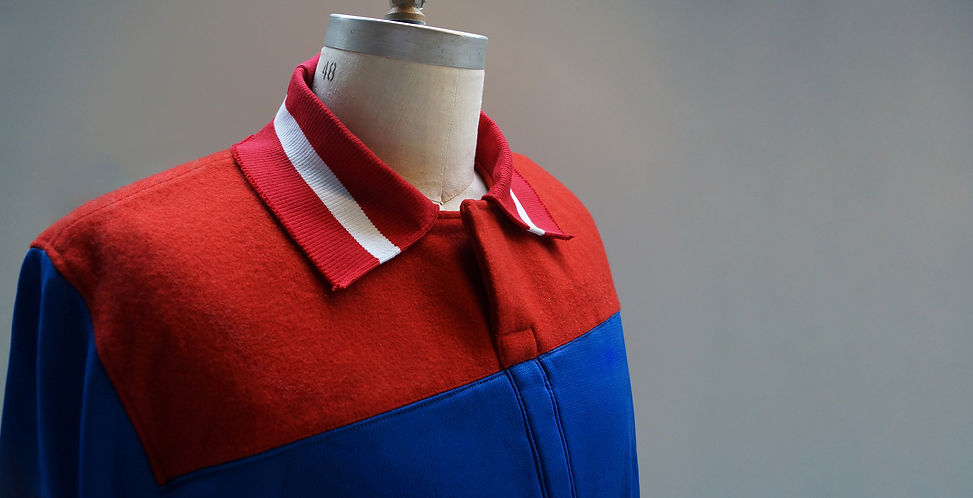
Softable
An Open Style Lab adaptive clothing research project following the research through making and co-creation processes
'Softable' is a high quality, soft and comfortable performance jacket promoting confidence by maximizing independence in dressing and through self-expression
The Centers for Disease Control and Prevention reports that 1 in 4 Americans (61 million) suffer from one form of disability or another that impacts major life activities. Studies by the United Nations indicate that more than 46% of the world's population of older people, aged 60 and above, have disabilities with more than 250 million experiencing moderate to severe disability (2015). The projected growth of older people with disabilities is expected to surge from 901 million in 2015 to 1.4 billion in 2030.
Clothing plays an important role in promoting and protecting the rights of people with disabilities and facilitating their full participation in society. Yet, the current availability of clothing meeting their needs is not reflective of the growing demand. Open Style Lab is a non-profit organization dedicated to creating functional wearable solutions for people with disabilities by bringing together teams of designers, engineers and occupational therapists. This past summer, OSL partnered with The Riverside Premier Rehabilitation and Healing Center to conceive and build accessible wearables that address the needs of seven clients who reside at the center. I was part of Team Robert, working as the designer, in collaboration with Herbert Ramirez - the engineer, and Alyssa Brandofino - the occupational therapist. Below is our case study of 'Softable', an independence maximizing jacket we co-created with our client Robert.
Client Interviews
Robert uses a mechanical lift for all transfers and requires full-time caretaker assistance. At our first meeting, he was very quiet and responded to our questions with very short answers that sometimes contradicted each other (likely the effect of forgetfulness). Our challenge was to get him to talk more about his lifestyle, and his life experiences in general. We had been given some general background information about Robert by the team at Riverside, but for our purposes we needed to go deeper into the specifics to really understand Robert as a person.
We also conducted our own project-specific clinical evaluation which included a manual muscle test, the Mini Mental Status Examination, the Moberg Pick Up Test and other general question and answer style evaluations.

ROBERT
72-year-old, male
Wheelchair user
US Air Force veteran
Avid Red Sox fan
After several interview sessions, we learned that Robert really enjoys baseball and is an avid fan of Red Sox. We realised that talking about Red Sox is a great way to get him to open up more about his life. So using Red Sox as a common reference point, we learned through our interviews that the experience of well-being for Robert is significantly influenced by his level of confidence. The more clinical aspects of his well-being were been routinely addressed at the rehab center, but our challenge was to find ways to promote his well-being through non-clinical means, clothing being one key element that can promote his self-confidence.

LEFT: Clinical evaluation summary and impact of each aspect on dressing
Four design objectives


Prototype 1
Prototype 1
A sporty jacket was designed with zippers across the chest, then sleeves, all the way to the wrists. The jacket also featured a longitudinal center-front zipper opening. By using the full length of Robert's arms, from one wrist to another, as an opening, we expected it to be easier to put the jacket on as this considerably minimized material pulling and turning of the torso that is usually required with more traditional jacket designs.
We placed the jacket on Robert's back and asked him to put his arms in the sleeves, then zipper the jacket, starting from the wrist going across the sleeve and ending on the chest (for both arms).
Main challenge
It was not a natural association for Robert to zipper his left sleeve with his right hand, and zipper his right sleeve with his left hand. He repeatedly tried to zip-close his right sleeve with his right hand and his left sleeve with his left hand as these were more natural associations for him. But the jacket design required him to switch hands as it was impossible to reach the zipper pull near the wrist with that same hand. Unzipping the sleeves, however, was not difficult for Robert.
Prototype 2

Prototype 2
Seeing the challenge with prototype 1, we asked Robert to put on prototype 1 front to back. He had no trouble with it; so we designed prototype 2 to be donned from the front. A longitudinal seam was placed posterior to the right shoulder and was to function as the main opening. We decided to not place the seam at center back to prevent pressure sores developing near the spine area as Robert's back is constantly in contact with his wheelchair due to his posture. Part of the right shoulder was also designed to come apart for the jacket to fully open on the right side. Pulley straps were placed on the front side that connected to the back side at this right shoulder seam and at the back opening. We experimented with both magnets and velcro as a way to close the back.
Main challenge
The velcro, as expected, was too strong and required a lot of strength to undo which was not comfortable for Robert. Some of the magnets stuck to the back of Robert's wheelchair and distorted the overall look of the jacket. The stretchy jersey material used for the prototype had too much stretch that despite Robert pulling on the straps as hard as he could, the back often did not close as the jacket material itself would simply stretch more.
Prototype 3: chest and neck straps
Prototype 3
The jacket opening was moved directly posterior to the spine but the two back side panels overlapped at center-back avoiding a seam that could potentially lead to pressure sore. The two sides were connected via straps that wrap around the front of the collar. The straps were partially exposed on the chest area to enable Robert to pull down from them evenly to close the back.
Main challenge
When Robert pulled down the exposed straps, the back did not successfully close. The angle of pull was difficult for Robert which led to him pulling from the straps in unintended way that resulted in him pulling on his back which made him uncomfortable.




Prototype 4: Robert pulling from waist straps & center back view
Prototype 4
A revised pulley system was designed to sit on the waistline. A strap was connected to each back side panel which wrapped around the opposite side of the body to meet at the front. Custom 3D printed magnetic snaps were designed to hold both straps in place at the front. Side pleats and stretchable armholes were added for extra room to reduce the amount of shoulder motion needed to pull the jacket over the head during doffing.
Main challenge
The straps worked really well for closing the back; but a second set of straps were needed for Robert to re-open the back independently.
Final Iteration
Prototype 4 was developed further to include sleeve shaping (for more tailored look suited to wheelchair use), a second set of pulley straps for opening the back (the two sets were color-coded for easy differentiation) and other fit and look related adjustments such as shorter back length and wider collar.
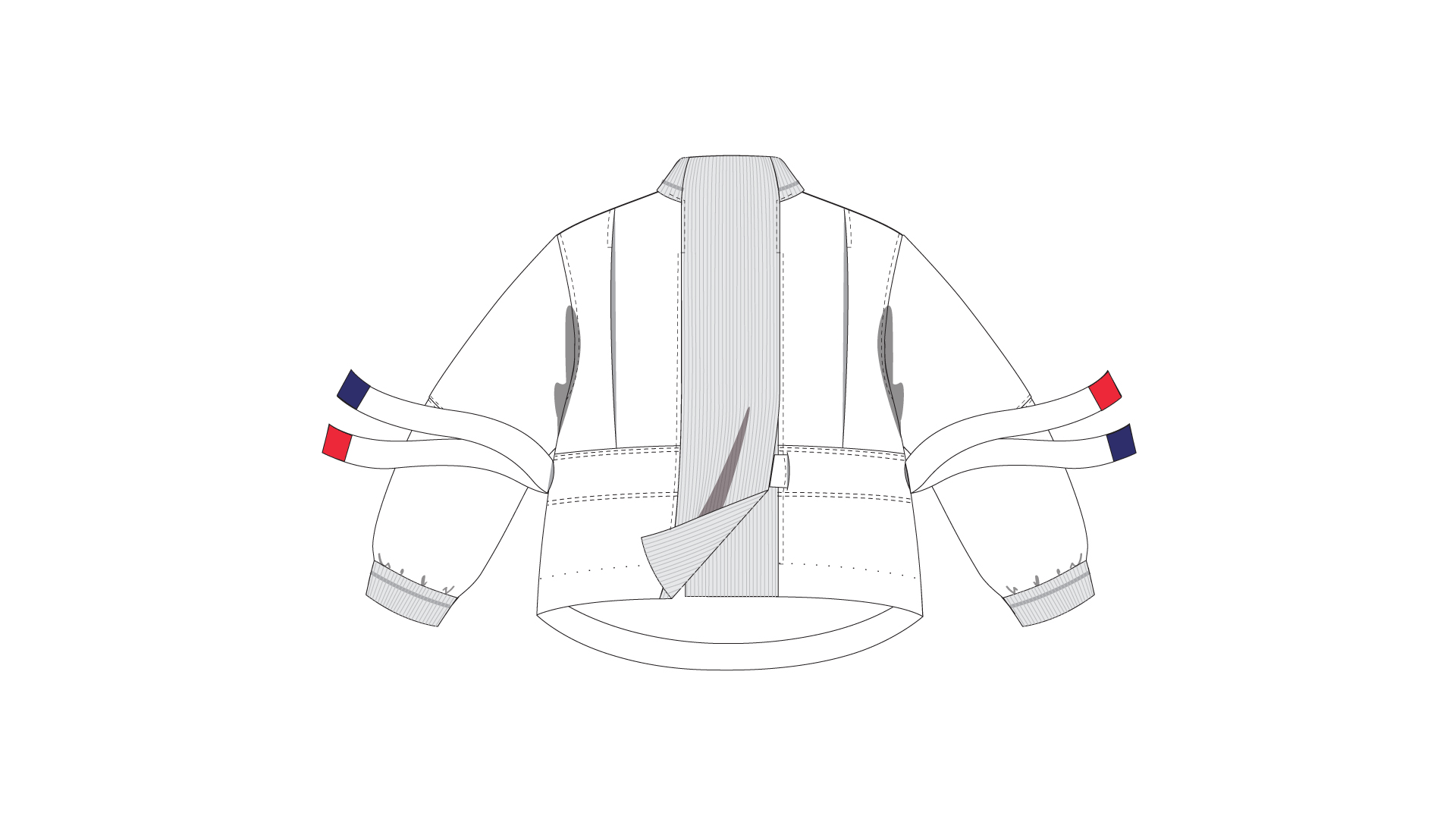

Robert wearing his Softable jacket
Shaped front pockets for hiding the straps without bulk
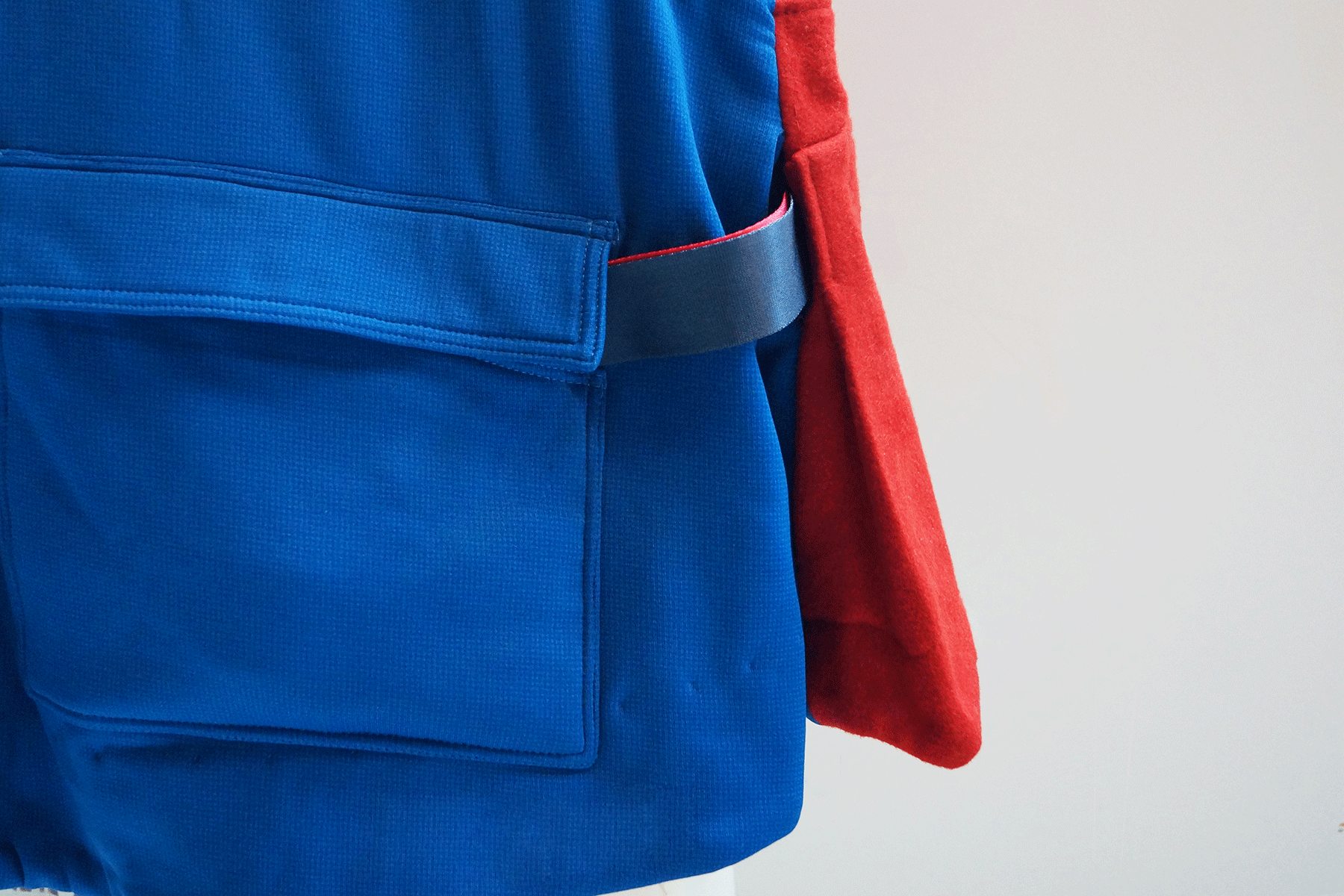
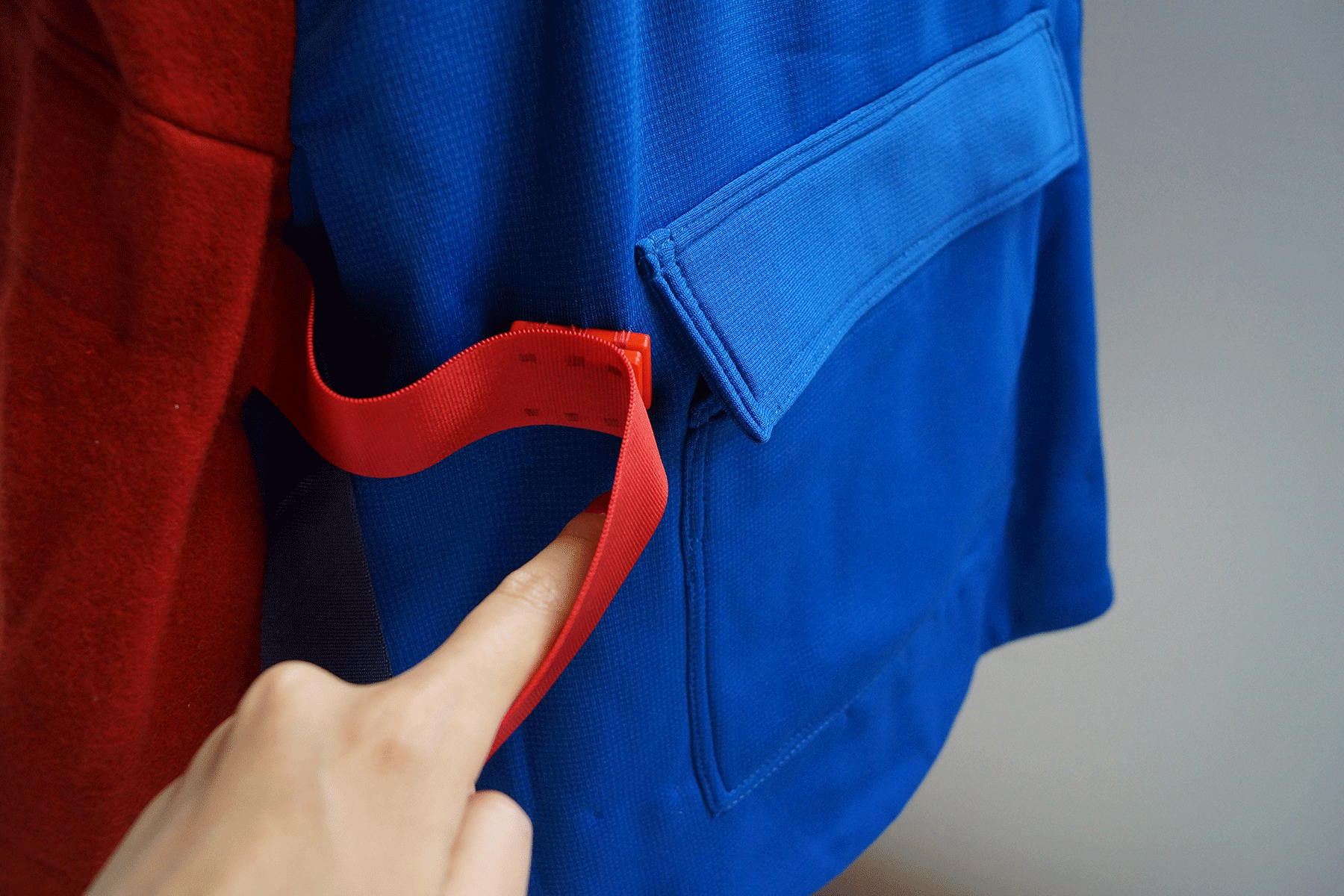
Custom 3D printed magnets hold the straps in place
Back pleats for extra room



Back pleats are meshed for ventilation
Color-coded strap stoppers
Recycled Polartec materials for both outer shell and lining

Functional Materials: Polartec & Woolmark
For the main shell of Softable we used a Woolmark/American Woolen medium-weight wool coating material for its breathable and appropriate-for-all-seasons properties. Wool is naturally odor resistant and has excellent moisture wicking properties making it suitable for both warm and cold environments.
For the second, contrast main shell material, we used Polartec's Hardface Jersey. It is a blend of recycled polyester and spandex with good stretch and insulation properties. Most importantly, it has all the “softable” qualities including being soft, lightweight, reasonably stretchy, and moisture wicking.
Another Polartec material, the Power Gridline made of 100% recycled polyester, was used as lining. With a soft grid texture, it is lightweight, odor resistive and has good moisture wicking properties, as well a reasonable amount of stretch.
The properties offered by each material along with Robert’s input on what he deemed “softable” dictated the decision to pursue these particular fabrics for the final garment.
Design Objectives
After initial evaluations during which we sought more clarity on Robert's needs, we decided that four key clothing-centered objectives could be used to address Robert's personal well-being.
Iterative Prototyping
We decided to design a jacket that would maximize Robert's independence during dressing by accommodating for his limited range of motion and strength. The jacket, as opposed to other types of garments, was chosen as it is a high-visibility clothing that he can wear to events and social gatherings, and, if designed well, could also help promote his confidence during social interactions.
____1 Design that maximizes independence
Independent donning (putting on clothing) and doffing (taking off clothing) are important factors influencing a person's feeling of well-being. For someone like Robert who is largely dependent on his caretaker's help when getting dressed, clothing features that maximize his independence are of great value. We considered closures (pulls vs. conventional buttons & zips) as well as garment silhouette in regards to independent dressing.
______________________2 Softable materials
Softable was a word Robert used to describe the feeling he wanted from his clothing. Quite simply, it stands for 'soft' and 'comfortable'. The team decided that the definition of softable could be extended to cover the whole range of properties that can help optimize temperature regulation, namely moisture wicking, odor/sweat resistant and stretch properties, as well as good breathability.
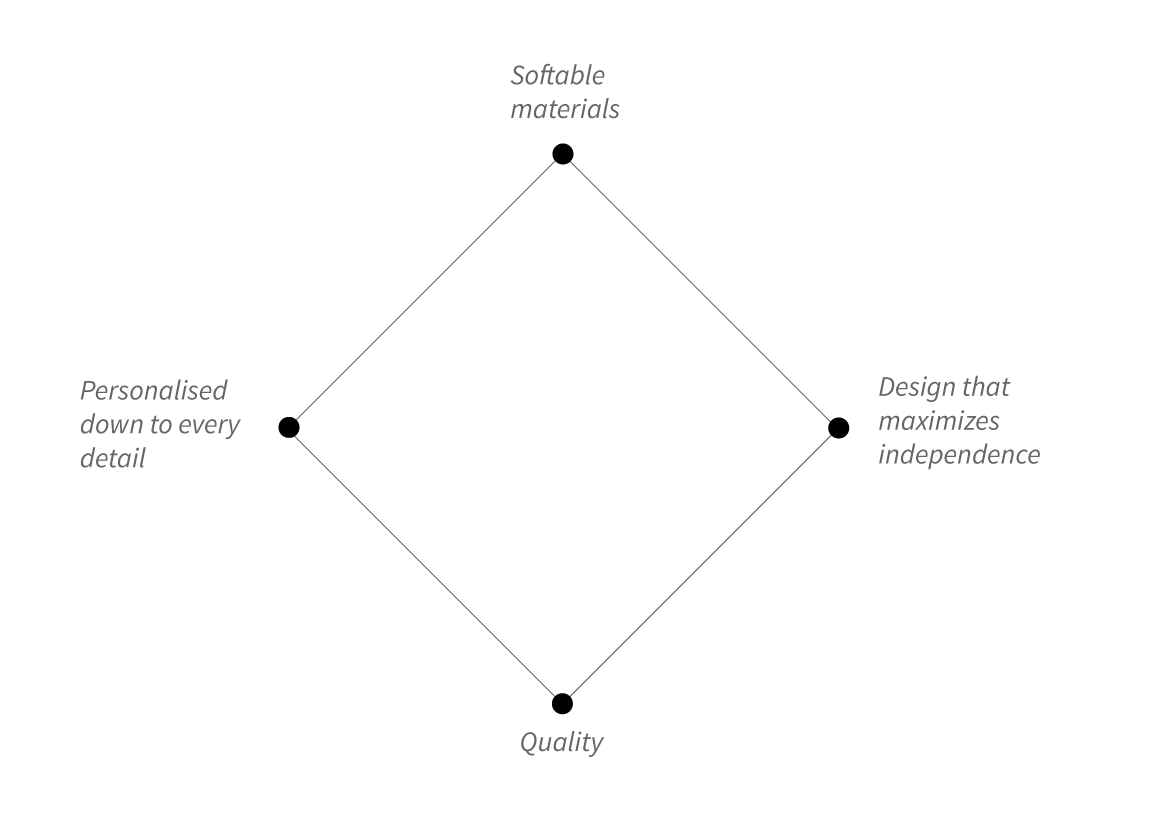
_______3 Personalised down to every detail
Nearly every time we saw Robert, he wore at least one piece of Red Sox themed clothing. Given his deep connection with Red Sox, we decided to use the Red Sox colours (red, white and blue) in his garment. We also did a mini colour test and a mini blind texture test with Robert to 1. get a sense of his personal thresholds for 'soft' and 'comfortable', and 2. incorporate more of his personal input in the final product. Personalisation and sense of ownership are considered effective ways to elongate garment lifetime as users are more motivated to look after their clothing, as well wear them for longer. This tied well with our fourth design objective focused on quality.
_____________________________________4 Quality
The Riverside Premier Rehabilitation Center operates a central laundering facility in the basement. It is the responsibility of the caretakers to check for items that need laundering and send them to the laundry. There is no system put in place that effectively allows residents to have a say on how each garment should be laundered and this occasionally leads to garments getting washed/dried using the wrong laundering cycle. Robert specifically requested that we make our design durable so that it will last him for longer.